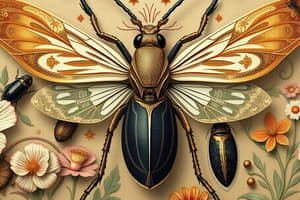Podcast
Questions and Answers
What are the two main domains life can be categorized into?
What are the two main domains life can be categorized into?
- Bacteria and Eukarya (correct)
- Archaea and Monera
- Bacteria and Fungi
- Eukarya and Protista
Which kingdom do plants belong to?
Which kingdom do plants belong to?
- Protista
- Plantae (correct)
- Animalia
- Fungi
What is an animal adaptation that aids in flight, insulation, and display?
What is an animal adaptation that aids in flight, insulation, and display?
- Spines
- Feathers (correct)
- Butterwort
- Camouflage
Which plant adaptation involves sticky leaves that attract and trap insects for nutrition?
Which plant adaptation involves sticky leaves that attract and trap insects for nutrition?
What is the estimated number of known species within the Kingdom Animalia?
What is the estimated number of known species within the Kingdom Animalia?
In which kingdom do animals belong?
In which kingdom do animals belong?
What is the process by which species change over time?
What is the process by which species change over time?
Which of the following describes the conversion of light energy into chemical energy by plants?
Which of the following describes the conversion of light energy into chemical energy by plants?
What is the term for the variety of life forms within ecosystems?
What is the term for the variety of life forms within ecosystems?
Which process involves breaking down dead organisms and returning nutrients to the ecosystem?
Which process involves breaking down dead organisms and returning nutrients to the ecosystem?
What helps control population sizes by carnivores eating herbivores?
What helps control population sizes by carnivores eating herbivores?
Which theory explains how evolution occurs through variations, selection, and reproduction?
Which theory explains how evolution occurs through variations, selection, and reproduction?
Flashcards are hidden until you start studying
Study Notes
Diversity in Plants and Animals
Diversity refers to the variety of life forms in our natural world, encompassing an array of species, each with unique characteristics and adaptations. In this article, we'll delve into the realm of plants and animals, exploring their classification, adaptations, and the role they play in ecosystems and evolution.
Classification
Life can be categorized into two domains: Bacteria and Eukarya. Eukarya, in turn, is divided into six kingdoms: Animalia, Plantae, Fungi, Protista, Archaea, and Monera (which belongs to Bacteria).
Plants are classified in the Kingdom Plantae, which contains over 370,000 known species. Animals, on the other hand, belong to Kingdom Animalia, and they're estimated to consist of approximately 1.5 million known species.
Adaptations in Plants and Animals
Adaptations are physical or behavioral traits that enable survival and reproduction in a particular environment.
In plants, adaptations can include structures like:
- Trichomes (hair-like protrusions) on leaves, which can deter herbivores or reduce water loss.
- Spines on cacti, which protect the plant from herbivores and help retain water.
- Butterwort, a plant with sticky leaves that attract and trap insects, providing a source of nutrition.
Animal adaptations include:
- Feathers in birds, which aid in flight, insulation, and display.
- Camouflage in animals like the Arctic hare, which helps them blend in with their surroundings and escape predators.
- Electricity production in fish like the electric eel, which can stun predators or prey.
Ecosystems and Biodiversity
Ecosystems are communities of living organisms and their environment, interacting in specific ways to maintain stability and productivity. Biodiversity refers to the variety of life forms within ecosystems.
Plant and animal communities interact through:
- Primary production: Plants convert light energy into chemical energy through photosynthesis, forming the base of the food web.
- Herbivory: Animals like deer and grasshoppers eat plants, using their energy and nutrients.
- Predation: Carnivores like lions and wolves eat herbivores, which helps control population sizes.
- Decomposition: Organisms like earthworms and fungi break down dead organisms and return nutrients to the ecosystem.
Evolution in Plants and Animals
Evolution is the process by which species change over time, resulting in new variations and adaptations.
Darwin's theory of natural selection explains how evolution occurs through three main components:
- Variation: Different traits exist within a population.
- Selection: Some traits are more advantageous in a specific environment, increasing an organism's chance of survival and reproduction.
- Reproduction: Organisms with advantageous traits pass on these traits to their offspring, leading to the accumulation of favorable traits in the population over time.
Conclusion
The diverse array of plant and animal species that inhabit our planet are not only fascinating to observe but provide valuable insights into the intricate relationships and adaptations that have shaped our world. By understanding and appreciating the complex interactions between species, we can better appreciate the importance of biodiversity and the need to conserve our natural environment.
Studying That Suits You
Use AI to generate personalized quizzes and flashcards to suit your learning preferences.




